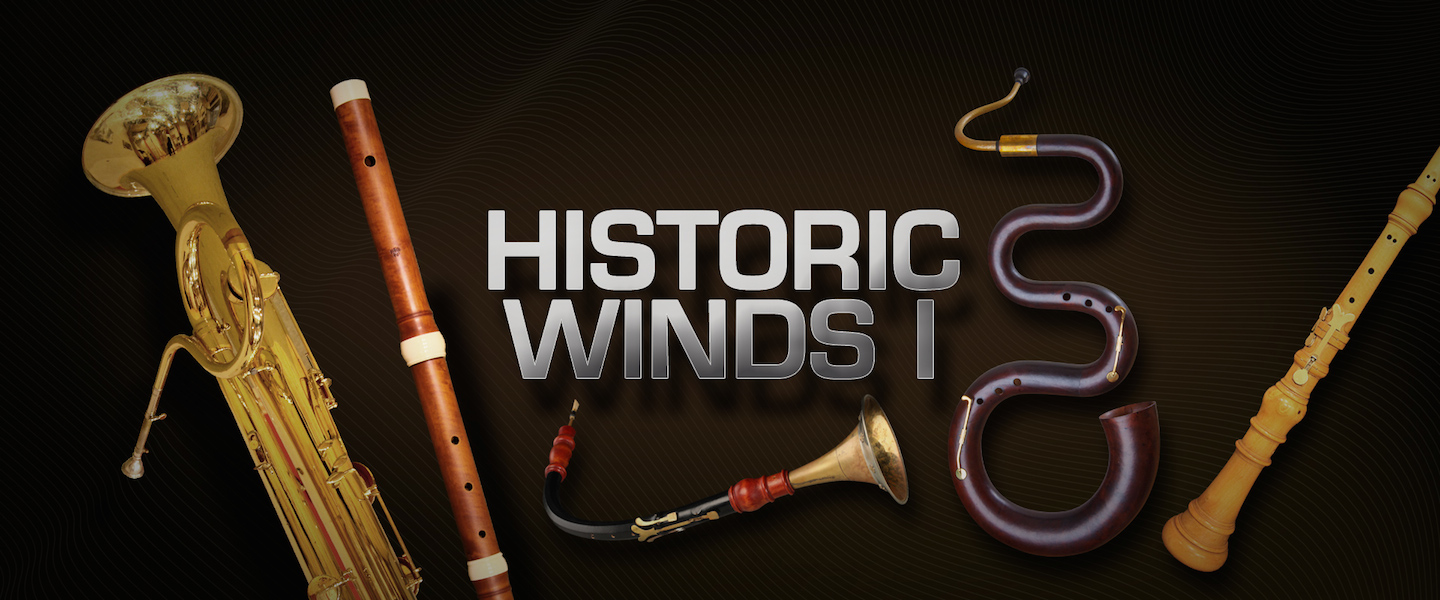
- Sea Breeze
- Fantasia for transverse flute
- Mistral - Traverso Flute
- The Lost Princess - Baroque oboe
- Oboe concerto no. 2, allegro e non presto
- Cantata no. 6, Aria - Oboe da Caccia
- Sun Dance - Oboe da caccia
- Ice Cream Man - Ophicleide
- Duettino no. 3 - Methode Elementaire pour Ophicleide
- The Lost Prince - Serpent
- Sonata V in D minor, adagio - Serpent
Open External Player
HISTORIC WINDS I
Vienna Instruments Collection
Calculating your price
Related Products
A Renaissance of Winds
The instruments of Historic Winds I are also available separately as SYNCHRON-ized Historic Winds Packs, re-edited, updated and optimized for the Vienna Synchron Player.
Whether you’re following an authentic performance practice or you’re just looking for new inspiring sound sources – Historic Winds I offers some beautiful and unique instruments! This Collection features recordings of five rare instruments from the Renaissance and Baroque periods: Transverse flute, Baroque oboe, oboe da caccia, ophicleide and serpent.
The transverse flute (Baroque flute, flauto traverso, side-blown flute) is a reedless woodwind instrument. Although the instrument had already appeared in the 12th century in Central Europe it experienced its golden era in the Baroque period as a predecessor of the modern concert flute. Unlike the modern flute the Baroque flute has just one valve and a limited key range of about 2½ octaves. The body is made of ebony, granadilla wood, boxwood, or olive wood, thus its warm and soft sound is more similar to the recorder than to the sound of a modern (transverse) flute. Today Baroque flutes are played as part of the historically informed (authentic) performance practice.
The Baroque oboe is a double reed woodwind instrument that appeared in the mid-17th century. It is also called “hautbois” which is derived from the compound French word haut (“high”, “loud”) and bois (“wood”, “woodwind”), covering the soprano range from c1 to d3. As opposed to the modern oboe the Baroque oboe has only three keys. In order to produce higher pitches, the player has to “overblow”, meaning to increase the force of air to reach the next harmonic.
The oboe da caccia covers the alto register of the Baroque oboe and looks like a hunting horn with its curved tube and brass bell. It is a transposed instrument in F, so it sounds a 5th lower than the oboe. Bach wrote parts for the oboe da caccia in his cantatas, passions, and especially in his Christmas Oratorio. The successor to the oboe da caccia is the English horn.
The ophicleide is a conical-bore brass instrument belonging to the bugle family that is similar to the tuba. It was invented in 1817 by French instrument maker Jean Hilaire Asté and replaced the serpent that was considered outdated in the Romantic orchestra. Ophicleide is derived from the Greek word ophis (“serpent”) and kleis (“keys”), since it was conceived of as a “serpent with keys”. Its cupped mouthpiece is similar to modern trombone and euphonium mouthpieces. The ophicleide is most famously used in Berlioz’s “Symphonie Fantastique”, but also Wagner and Verdi wrote parts for it. Brazilian choro bands used the ophicleide well into the 20th century until it was superseded by the saxophone and the tuba. There have been claims that the ophicleide is a direct ancestor of the saxophone when supposedly Adolphe Sax put a woodwind mouthpiece on an instrument he was repairing, allegedly leading him to design and create a purpose-built instrument.
The serpent (latin: serpens “snake”) is easily recognized by its exceptional visual appearance. The instrument was developed in France in the 16th century, covering the bass register of the zink (cornett/cornetto) family of instruments (for more details on the zink please have a look at Historic Winds II). Serpents are usually made out of wood covered by leather. The round, brass-type mouthpiece is similar to that of a trombone or tuba so the instrument can be considered as an ancestor of the tuba. However, the wooden construction and the fact that the instrument has six finger holes rather than valves makes it difficult to classify it clearly as either a woodwind or brass instrument. In the middle of the 18th century the serpent began to appear in military bands and orchestras, where it stayed until the middle of the 19th century, as it was the only wind instrument that could perform at louder volumes in larger ensembles and venues. Various composers of the Baroque, Classical and Romantic periods wrote parts for serpent, e.g., Handel (Music for the Royal Fireworks and Water Music), Haydn, Mozart, Beethoven, Mendelssohn (in “A Midsummer Night’s Dream”), Berlioz (in his “Symphonie fantastique”), and Wagner (in his opera “Rienzi”). The serpent was rediscovered in the 20th century by legendary film music composers such as Bernard Hermann (1959: Journey to the Center of the Earth) and Jerry Goldsmith, who used it to create “alien” sounds for Ridley Scott’s legendary sci-fi horror movie “Alien” (1979). The instrument is extremely hard to play and requires not only great skills, but also a lot of practice and effort from the player. Even under perfect conditions it is very difficult to produce a stable, centered tone. Parts originally written for the Serpent were therefore replaced by the Ophicleide and later by the contra bassoon, French horn, trombone, tuba or euphonium.
| Library | |
|---|---|
| Sample Amount | 19,583 |
| Download File Size | 3.8 GB |
| Installed File Size | 6.6 GB |